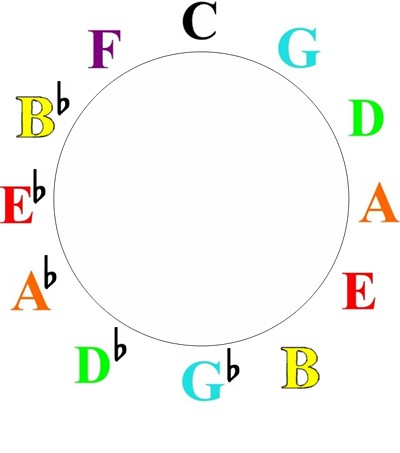
There’s almost an infinite number of ways to approach chord progressions to learn how to play them. I find that the most helpful methods are those that are systematic; in other words, ones that have a logical way to execute on the keyboard. This makes the progression easy to understand and apply to any key that you might be playing in.
The chord progression learning tool that I want to share with you today is moving from a dominant 7th chord to a Major 7th chord. The chord voicings in this article are not going to be complex or require a lot of mental strain. They’re actually just enough to help you learn the concept and give you one more useful tool to use in your music. So, let’s take a look at this chord progression learning tool.
First of all, let’s cover the Major 7th chord. Just to clarify, you should have a good grasp on Major 7th chords. But to refresh your mind, we’ll define them as well as dominant 7th chords.
By definition a Major 7th chord is a Major chord that includes the 7th tone. This is also known as the Major 7th. To find the Major 7th, you just count up 7 notes from the root note of the chord. This is going to include all of the notes that are in the corresponding key of the root chord.
Let’s use C Major 7th and C dominant 7 as an example
First, find the Major 7th tone in the key of C Major by counting to 7 from the tonic (the first note) The shortcut to finding the Major 7th tone is to simply locate the note that is one half step below the root.
The shortcut to finding the Major 7th tone is to simply locate the note that is one half step below the root.  Of course, it can be played an octave higher or anywhere else on the keyboard. By definition, it’s played above the C Major chord to form the C Major 7th.
Of course, it can be played an octave higher or anywhere else on the keyboard. By definition, it’s played above the C Major chord to form the C Major 7th.  A dominant 7th tone is also known as the flatted 7th. So, if you can locate the Major 7th, all you need to do is lower it one half step. You now have the dominant 7th tone.
A dominant 7th tone is also known as the flatted 7th. So, if you can locate the Major 7th, all you need to do is lower it one half step. You now have the dominant 7th tone. 
The shortcut to finding the dominant 7th tone is to locate the note that is a whole step below the root. Again, it can be played anywhere, but by definition, it’s played above the C Major chord to form the C dominant 7th chord.
We’re going to also use the circle of fifths as a tool to progress with these two types of chords. I won’t cover the circle of 5ths in detail in this article other than to just define it as a geometrical representation of the 12 Major keys of music.
Now that we’ve defined both chords in our chord progression as well as using the circle of fifths to guide our progression sequence, let’s take a look at how we’ll be voicing them. In case you don’t know, “voicing” is simply defined as the arrangement of notes in any given chord.
We’re starting out with the C Dominant 7th chord. We’ll be playing C (which is the root) in our left hand. Our right hand will be playing B flat (the dominant 7th tone with E (the 3rd) on top of it. As you saw in the earlier example, there’s also a G in this chord which is the 5th. But for this progression, we’ll omit the G because it’s common to leave out certain tones in a chord when they sound better by doing so. The next chord in our progression is F Major 7. The transition to this chord is going to be very smooth due to the fact that you’re going to retain one of the notes from the chord you just played.
The next chord in our progression is F Major 7. The transition to this chord is going to be very smooth due to the fact that you’re going to retain one of the notes from the chord you just played.
Your left hand will play F as the root of the F Major 7 and in your right hand, you’ll move from B flat to A (the third) while keeping the E (now the Major 7th) above it. This is now producing the F Major 7 chord.
Play both of these chords on your piano. Can you hear how smooth the transition is from C Dominant 7 to F Major 7? This smooth transition is referred to as “voice leading”. Not only does it make chord progressions easier to play, it makes them sound really good.
 Now on to using the circle of 5ths. As you can see, C is placed on top of the circle. This is always a starting point to learn just about anything on piano. If you look counterclockwise to C on the circle, you’ll find F. These happen to be the first two chords in our progression, and ones that we’ve already covered.
Now on to using the circle of 5ths. As you can see, C is placed on top of the circle. This is always a starting point to learn just about anything on piano. If you look counterclockwise to C on the circle, you’ll find F. These happen to be the first two chords in our progression, and ones that we’ve already covered.
Moving counter clockwise beyond F is B flat. Even though the notes are different, the structure is exactly the same. So our next chord is going to be B flat dominant 7. You’re essentially going to “reset” back to the dominant 7th chord structure you started with.
From F Major 7, move the A down to A flat (a half step) and the E down to D (a whole step). Now you’re back to a Dominant 7th chord which is now B flat dominant 7. Continue with this formula moving counterclockwise around the circle of 5ths. You’ll notice that the bass notes alternate up and down for smooth left hand movement. After moving through the entire progression, you’ll end exactly where you started: on C Dominant 7th.
Continue with this formula moving counterclockwise around the circle of 5ths. You’ll notice that the bass notes alternate up and down for smooth left hand movement. After moving through the entire progression, you’ll end exactly where you started: on C Dominant 7th.
Ok, so here’s what the whole progression will look like:






"Were running out of keyboard so we need to move up to a higher register."





This chord progression tool will benefit you most if you have a good grasp of Major Chords and some knowledge of extended tones. If you find it to be above your skill level, try only executing the right hand first and then add the simpler left hand movement.
You’ll find this chord progression learning tool to be musical and fun. You also have the option to play it anywhere on the keyboard, especially in higher registers where you don’t have to be concerned about the notes getting “muddy” as you do in the lower registers. Have fun and experiment.
Until next time, Go Play.
Greg Lee
Latest posts by Greg Lee (see all)
- What is a minor/Major 7 Chord? - October 26, 2023
- 7 Chord Substitutions that Professionals Use - October 19, 2023
- 5 Simple Chord Tricks to Sound Amazing - October 5, 2023



